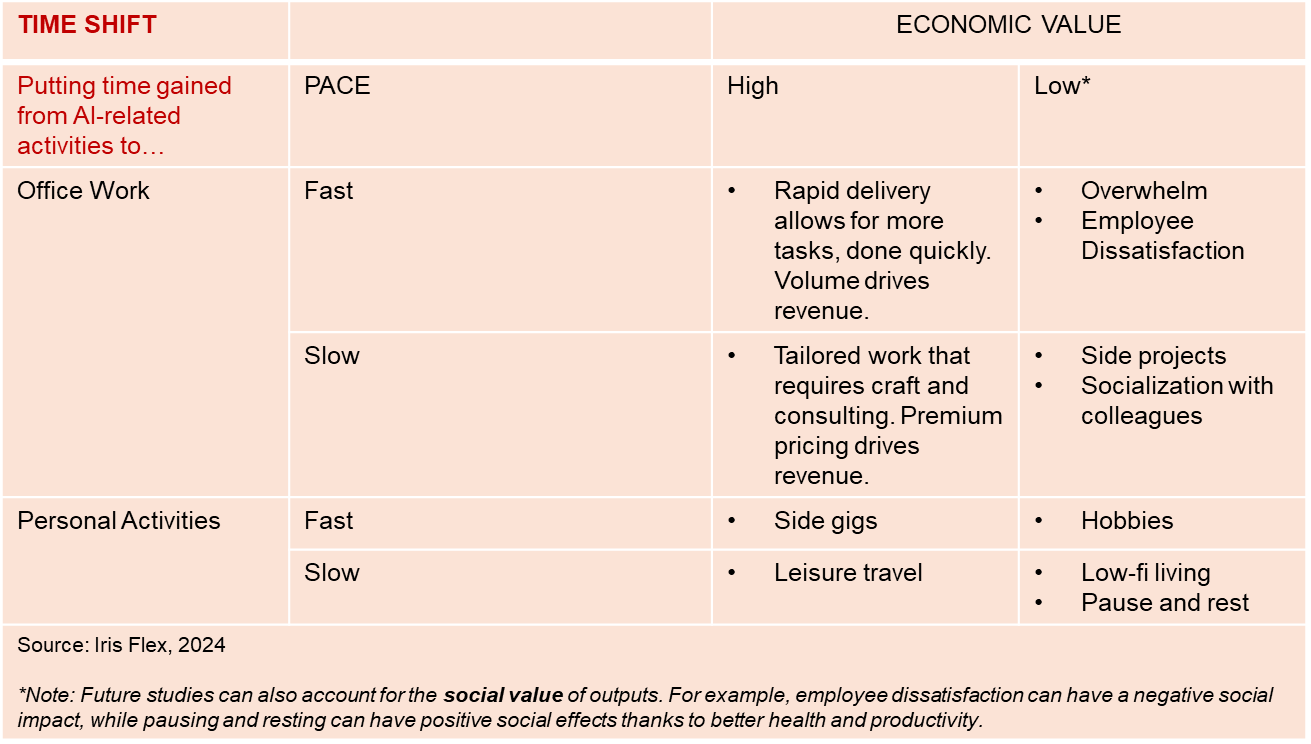Time Shift: Measuring the Impact of AI on Work and Play

Much of the discussion around AI’s impact on organizations focuses on time savings. Chipotle recently announced that it is hoping to reduce time to hire workers by as much as 75% thanks to the help of an AI assistant. Reddit’s Monica Benson reports the tech company’s designers saved more than 21,000 hours after adopting Canva. At Schneider Electric, a European company focused on sustainability, sales teams saved 5 hours per person in a week by adopting Copilot. The public sector also values efficiency: When PA Governor Josh Shapiro ran a pilot program with OpenAI among a select group of Commonwealth employees to use ChatGPT responsibly for public services and to make government more accessible. Based on insights gathered through bi-weekly employee feedback, the program delivered time savings of 105 minutes a day on tasks such as brainstorming, code and content creation.
There is some skepticism whether this all of these types of activities generate material increases in productivity and efficiency for the economy at large, as Noble Prize winner Professor Daron Acemoglu famously wrote here. And questions arise whether AI-driven work cycles can create employee burnout among those workers at the mercy of employers who expect more, faster. Upwork’s report, From Burnout to Balance: AI-Enhanced Work Models for the Future underscores a strong correlation between burn out and employee demands. According to Upwork’s survey of 2,500 global employees, including C-suite, full-time and freelance workers, 7 in 10 full-time employees are burned out and are struggling with employer demands on their productivity. Meanwhile more than 80% of global C-suite leaders acknowledge they increased demands on workers in the past year. The majority (77%) of employees also report that AI tools have decreased their productivity and added to their workload in at least one area.
Where did the time saved with AI go?
With so much variation in AI applications in trial-and-error mode across different types of organizations, it may be impossible to land on a single truth. But one key concept organizations must measure at this juncture is time-shift. What happens to the time employees gain by using AI tools? Does it go into another rapid activity? Or, does it give schedules a breather allowing employees to focus on more tailored pieces of work – perhaps even a side gig? Who said we have to shift our time to more work? Some may be taking a much-needed mental health break or engage in a hobby.
Here's a simple framework to analyze the impact of AI on your organization and workforce, going beyond time savings:

An organization that fits AI into its work culture and flow should track the impact of time shift on employee productivity and satisfaction – and expect some variation depending on employees’ attitudes towards innovation and willingness to change. Tech-forward employees may feel attached to jobs that allow them to be efficient with their time. They might enjoy the freedom of spending their time gains on meaningful tasks and feel good about working for an innovative organization that empowers them to upskill. Some may even give their employers credit for enabling a balanced lifestyle. Those who do not receive sufficient training or fear job loss may express negative attitudes from doing more with systems they are not familiar with.
Time on and off are not mutually exclusive categories. An employee might be splitting the gained time across some tailored work and rest. Take communications professional Becca Chambers for instance. She has been featured in major media publications about the smart ways she deploys AI. She prefers those tools that get her information quickly with verifiable sources. She customized a ChatGPT bot to mimic her writing style to help with early drafts and wordsmithing. She is also deft at managing her time with AI. Becca is a neurodiverse individual and an advocate. Sharp as a whip, she is not shy about explaining how she uses technology to overcome challenges of working with a disability: “I have ADHD. Everything I do is slow or fast. Nothing is steady pace. AI helps with that.” She further explains: “Let’s say I have a low dopamine week: AI can help with menial tasks. If I have a high dopamine week, then I am doubling the work I can do in a week. AI helps me keep the momentum I have without breaking.” She concludes “My time save is (typically) going back to being productive,” but also notes how AI offers her flexibility to allocate her time “This lets me do what I need to do. Take a nap, do stuff around the house. In that case, time goes back to me.”
As Becca exemplifies, the future of work is flexible. And now is the time to move from AI exploration to implementation, with measurement. With any change, organizations will face resistance along with adoption. Having a holistic view and gauging the extended impact of AI on our lives, going beyond time and dollar savings, can allow organizations fine tune their systems and increase both gains and employee satisfaction.
Posted at MediaVillage through the Thought Leadership self-publishing platform.
Click the social buttons to share this story with colleagues and friends.
The opinions expressed here are the author's views and do not necessarily represent the views of MediaVillage.org/MyersBizNet.


